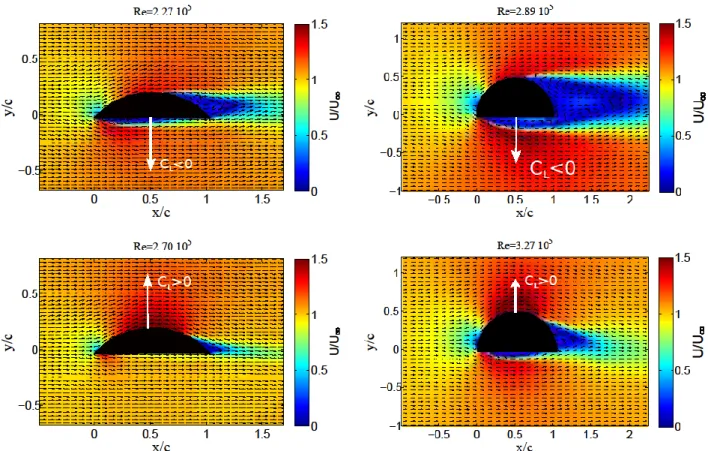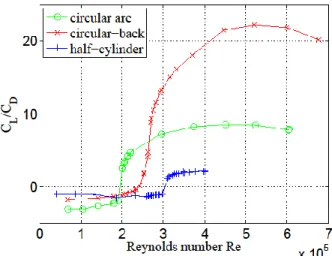Science Arts & Métiers (SAM)
is an open access repository that collects the work of Arts et Métiers Institute of Technology researchers and makes it freely available over the web where possible.
This is an author-deposited version published in: https://sam.ensam.eu Handle ID: .http://hdl.handle.net/10985/11396
To cite this version :
Patrick BOT, Marc RABAUD, Goulven THOMAS, Alessandro LOMBARDI, Charles LEBRET -Sharp Transition in the Lift Force of a Fluid Flowing Past Nonsymmetrical Obstacles: Evidence for a Lift Crisis in the Drag Crisis Regime - Physical Review Letters - Vol. 117, p.234501-1 à 5 - 2016
Any correspondence concerning this service should be sent to the repository Administrator : archiveouverte@ensam.eu
1
Supplemental material to “Lift crisis on non-symmetrical obstacles”
This supplemental material shows the results briefly given in the paper for three different sections.
Figure SM1: The three sections tested (bodies 2, 1 and 3 from left to right).
As shown in Figures SM2 and SM3, the same behavior is evidenced on the 3 tested sections showing a simultaneous lift and drag crisis.
Figure SM2: Lift and drag crisis on the three sections tested. The crisis is less abrupt for the circular-back profile than for the other sections.
2
Figure SM3: Time-averaged velocity field below (top line) and above (bottom line) the critical Reynolds number, for the circular-back section (left column) and the half-cylinder section (right column).
The following table summarizes the results obtained on the three sections.
Profile 1 Circular arc 2 Circular-back 3 Half-cylinder ReC (105) 2.0 2.5 3.0 CL0 0.08 0.24 -0.103 CL below -0.6 -0.3 -0.6 CL above 0.87 0.9 0.53 CD below 0.2 0.18 0.57 CD above 0.1 0.04 0.25 0.2 0.5 0.2 CL/CD below -3 -0.2 -0.1 CL/CD above (max) 8.5 22 2 Cx below 0.9 0.81 1.14 Cx above 0.45 0.18 0.5
Table SM1: Comparison between the 3 profiles. CL and CD are defined with the chord length c as the
reference length Cx is defined with the section thickness as the reference length. Values below and above
3 Comparing the circular-back section with the circular arc section:
- The critical Reynolds number Rec is slightly higher: 2.5 105 instead of 2.0 105,
- The lift coefficient above Rec is similar and the drag coefficient is about half;
- The lift coefficient below Rec is about half and the drag coefficient is similar.
Comparing the half-cylinder section with the circular arc section:
- The critical Reynolds number Rec is higher: 3.0 105 instead of 2.0 105,
- The lift coefficient above Rec is lower;
- The lift coefficient below Rec is similar;
- The drag coefficient CD (defined with the chord length) is far higher for all Re; the drag
coefficient Cx defined with the frontal area is similar (of order 1 below Rec, of order 0.5
above Rec).
Figure SM4: Separation point location x/c for the 3 profiles.
Figure SM5: Lift-to-drag ratio for the three different profiles. The circular-back profile has a large lift-to-drag ratio at high Reynolds numbers.


